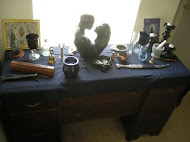I know, I know, I said I would have this up last night, and I didn't. I did try...but as I was trying to proof it, it just wasn't making sense, and I knew I needed to sleep. I'm sorry, but here it is - better late than never, I hope. I also hope you find it was worth the wait :)
I know, today is supposed to be about rituals, but since it is the Summer Solstice, Midsummer, Litha, I felt it would be acceptable to do a post on Litha and the various meanings, myths and lore associated with it. If you are looking for a Midsummer ritual, I have several posted:
This one is for those who are comfortable working with dragons (you'll see them a lot here, as we are definitely a dragon-friendly family *grin*). This one is more generalized. Here is one for those of you who practice solitarily. And finally, here is one more that is pretty general in scope.
Now, onward to Litha.
Image from Science Fiction & Fantasy Art
"Turn your face to the sun and the shadows fall behind you." -- Maori proverb
Summer Solstice is the longest day and shortest night of the year. From the moment of Summer Solstice, the Sun immediately begins to wane. The journey into the harvest season has begun. Midsummer has been one of the important solar events throughout the evolution of humankind. It was an indicator that the year was about to begin waning, thus winter would be again returning. Although not all the ancients were as precise in the calculations from an astronomical point, you can be sure that they were keenly aware of the sun's progression, and did most assuredly know when Solstice was upon them, as the sun appeared to stand still in its northern progression. It falls at the precise moment when the Sun's power is at it's zenith. It is the time of year when the noon sun appears to be farthest north from the celestial equator.
"Solstice" is Latin for "sun stands still" (sol "sun" and sistere "to stand"). Summer Solstice is so named because to the naked eye the sun appears stationary in its northern and southern progression.The ancients knew that life came from the sun, it was life giving, life supporting, without it life would be lost. The journey of the sun impacted life at every level in the course of time. It is only relatively recently, with the advances of electricity, greenhouses, and transportation networks, that human reliance on the passage of the sun has lessened. Even with this dependence lessening in this technological age, the sun and its path are crucial to our existence. However it is not as apparent today to many.
It is at Midsummer that the Holly King, God of the Waning Year, has encountered the Oak King and succeeded in usurping the reign of the year. In Celtic Mythology the Young God withdraws into the Wheel of the Stars and it is here he waits and learns before his rebirth at Winter Solstice. It is the time when Belenus, Belenos - the Sun god - begins to die. Balefires were kindled to light his downward path, until he will return again at the Winter Solstice, when the Yule logs and lit fir-branches will guide His return. We have evolved and no longer practice blood sacrifice of any sort, but the ritual murder of the sacred king was once a solemn European vegetation rite of Midsummer. He was not a king as we understand that term in modern times but rather the embodiment of male virility, a Hercules figure. He was crowned with roses and wreathed with myrtle, enjoyed the favors of the queen/priestess, but Midsummer was when he felt the stab of the thorns and his rule came to an end. The sacred king's sacrificial death ensured the fertility of the crops and the survival of the tribe.
The ekingi was symbolically beheaded as a part of the Bohemian Midsummer vegetation ceremonies. He wore a tree bark robe decorated with flowers, a bark crown bedecked with branches and flowers, a mask, and had ferns on his feet. He carried a hawthorn switch for a scepter and was accompanied by young people wearing bark girdles who carried wooden swords and willow bark trumpets. There was a chase through the village followed by a mock trial. If the king was found guilty, several hats would be placed atop his head so that they could be chopped off when he knelt down.
Midsummer celebrations began with Midsummer eve, as the Celts and many ancient groups, reckoned the beginning of day to occur at dream-time or nightfall. Through the progression of Christianity, Midsummer's Eve became Saint John's Eve, but the roots of Midsummer observations are and were firmly planted in their Pagan origins. The axis of Stonehenge, which aligns with the monument's entrance, is oriented in the direction of the midsummer sunrise. The Teotihuacán Temple of the Sun, a pre-Columbian temple located in Mexico, was also oriented to the sun's passage at the Summer Solstice. During the time of the ancient Egyptians, Sirius (the dog star) rose on the Summer Solstice (today it rises August 10) heralding the beginning of their new year, just before the season of the Nile's flooding.
Midsummer Eve is the evening of herbs. The herbs and flowers gathered this night are considered exceptionally potent. St John's wort, burdock, thorn, and nettle, harvested on Midsummer Eve, are hung on doors and windows and placed around the home for protection. The remaining plants were bundled, tied to a pole, and set up where grain would be brought at the next harvest. Farmers prayed to the goddess Kupole for a good harvest. The bundle of herbs, called the Kupole, represented her. Houses are decorated with fennel, orpine (also know as Sedum; live forever; stone crop), St. John's Wort and birch branches. Royal Fern (Raithneach na Ri) seeds which are gathered on midsummer are said to make the possessor invisible. They who find Royal Fern blossoms on Midsummer's eve become wise, lucky, wealthy and all around happy folk. Ferns generally reproduce via spores, but it was believed that fern seed was magical at Midsummer. Gathered on Midsummer Eve by spreading a white cloth below it, so as not to touch it with the hands, fern seed was believed to confer invisibility and the ability to understand the language of animals. Women wear braided circlets of clover and flowers, while men wear chaplets of oak leaves and flowers around their heads. In times past livestock were also decorated with garlands made of flowers, foliage, and oak leaves. St. John's Wort symbolizes the Wiccan festival of Summer Solstice. This herb, gathered on Midsummer Eve, is worn as an amulet or hung up over doors or windows as a charm. Gathered naked that night, it is used for fertility. Mugwort has magical powers when gathered on Midsummer Eve. A Mugwort garland woven at Midsummer, worn as a crown or used for viewing the bonfire through, was a charm to ensure that you would have no headaches or eye pain that year. The French wove garlands of it at Midsummer for protection against ghosts, magic, bad luck and disease for that year. Orpane/Midsummer Men (Sempervivum telephium, a variety of houseleek) was gathered on Midsummer Eve along with sprigs of red sage and used to divine the fate of lovers. Fennel was hung on doors on Midsummer Eve in medieval times to ward off evil spirits. Oil of St. John was a decoction of mistletoe that had been gathered on Midsummer Eve. It was believed to heal all wounds made with cutting instruments. In Scandinavian countries, the night before Midsummer, every young girl places a bunch of flowers tied with nine pieces of grass or nine flowers under her pillow, upon which she will sleep and dream of her future husband. In Ireland the young lasses place yarrow under her pillow to dream of her mate. The passion at Midsummer has escalated from the playfulness of Beltane to a more fervent intensity. Couples who handfasted the year before at Beltane, tend to marry in a more formal handfasting at Midsummer or Lughnasadh. Divination on matters of love are especially powerful Midsummer's eve.
Fire is an important aspect to Midsummer celebrations. The balefires, bonfires on hilltops, at crossroads, or any place where folks could gather, reaches far back through the progression of time. The fire of Midsummer is traditionally kindled from the friction of two sacred woods, fir and oak. Nine different types of herbs are thrown upon the Midsummer fire. These consist of mistletoe, vervain, St. John's Wort, heartsease, lavender, and a choice of four others, chosen from herbs sacred to this season such as yarrow. Folks would feast, dance and jump the fire for luck and fertility. The herds were driven through the embers in days long ago to purge disease and illness from them. When the fires had burned down, folks would carry ashes back to their homes to sprinkle on fields, and lay embers on the hearth. Ashes bring powers of protection, health and luck. The charred embers from a Midsummer bonfire are potent magic, charms against injury and bad weather. They are placed in fields or around trees for agricultural fertility, placed in meadows and atop houses to protect them.
Bonfires are kindled for health, fertility, love, sacrifice or purification. There is a long European tradition of lighting bonfires at Midsummer, especially of oak wood and in high places. Twin bonfires were common. Smoke of the green oak, burned on Midsummer Eve fires, gives inspiration to those who dance between the twin sacrificial fires all night. In parts of England the Midsummer fires were lit in the fields to bless the apples. Midsummer bonfires were jumped over to make flax grow as high as the people could jump. In some parts of Germany young people jumped over Midsummer bonfires, and people in some parts of France held branches of nut trees when they jumped the bonfire. These branches were then hung over the doors of cattle stalls. On the Isle of Man blazing gorse was carried several times around the cattle folds on Midsummer Eve. Mugwort was sometimes thrown on the Midsummer bonfire. The ashes of the bonfire were scattered as a fertility charm.
In some places a Midsummer Tree was used to kindle the bonfire. These were made of fir or pine and decorated by girls with flowers, garlands and red ribbons. The bonfire was kindled of the tree that night, the garlands tossed back and forth across the blaze by boys and girls. Couples held hands and jumped over the embers three times. Singed garlands were saved to burn in the hearth during thunderstorms, or fed to sick or calving cows. Swedish Midsummer trees, were made from tall, straight spruces with their branches stripped off. Wood was sometimes attached so that the trees represented a man with his hands on his hips. The Midsummer tree was decorated by village maidens with leaves, flowers, strips of cloth and gilt eggshells. A large vane or flag was placed on top.
Moroccans and Algerians threw incense and spices on their Midsummer bonfires to make the flax or hemp grow tall. Celts, Druids and Scandinavians gathered mistletoe at Midsummer. In Bohemia, fir cones gathered before sunrise on Midsummer Day were believed to confer invulnerability. Wild thyme collected on Midsummer Day in Bohemia was used to fumigate trees at Solstice as a fertility charm, to make them grow well. It was also believed there that fern seed bloomed with fiery golden blossoms on Midsummer Eve, and that the person who climbed a mountain holding it would find a vein of gold and see the treasures of the earth shining with a bluish light. In Germany, St. John's Flower/St. John's Blood/Mouse-eared Hawkweed (Hieracium pilsoella) was uprooted with gold coins on Midsummer Eve. In Sweden the Midsummer mistletoe was attached to the ceiling of the house, horse stall or manger to render the Troll powerless to inflict harm on people or animals. In Italy young singles gathered around a standing stone at Midsummer, the boys wearing green ears of grain and the girls wearing flax flowers, to leave plants on the stone. The affections of a couple were believed to last as long as the plants stayed fresh upon the dolmen. In Moselle, France a good vintage was expected if the Midsummer Eve fire wheel was still aflame when it rolled into the river. Nettles were planted or put into water on Midsummer Eve in Sicily. The way they were found on Midsummer Day, blooming or fading, was an omen, especially as to fortune in love. In Italy wheat and barley were sown in small pots a few days before Midsummer. Each pot represented a specific person. Fortune and good luck were believed to come to those whose grain had sprouted well by Midsummer Day, bad luck to those whose grain had not. In some parts of ancient Egypt the somber rites of the presentation of the first sheaf of harvest wheat to Min took place at Midsummer. Dirges were sung for the child Linus at Midsummer during the Phoenician flax harvest. Inti Raymi, the Feast of the Sun for the Incan, marked Winter Solstice in the southern hemisphere. Sun Dances were the Native American form of celebration. In Germany, Latzman, the Lazy Man of Midsummer Day festivities, was a conical or pyramidal wickerwork frame covered with fir sprigs. In Ireland torches made of bundled reeds were carried on Midsummer Eve.
Water is the other important aspect of Midsummer. In times past folks swam in waters that flowed towards the rising sun as it climbed in Midsummer morning sky. Bathing in springs and rivers on Midsummer brings healing, cleansing and protection. The dew of Midsummer is said to bestow health to whomever drinks of it. Especially powerful is fetching running water of Midsummer morn and mixing it with ashes from the bonfire, sprinkling it around the house, yard and on oneself to bestow protection and luck.
Midsummer is the time when everything is abundant and flourishing. Flowers smell their sweetest, colors are their most vibrant, trees are their greenest, berries are their sweetest, and faeries are their most playful, it is the time that nature's lavishness has reached a pinnacle point. It is said that during a full moon on Midsummer Eve a mortal may witness fairy dances and celebrations, that the door to the Faery Realm is opened, and twilight to be the best time for faery magic. Be sure to leave an offering for the fey on Midsummer eve, so they may think fondly of you and yours. It is a good time for empowerment, for strong magic and male rituals, for handfasting and communing with Nature Spirits, for workings of consummation or culmination.
Celebrate Mid-Summer with fire and singing and feasting, with all-night vigils and torch lit processions. Weave green boughs and crowns of flowers. Dance around a bonfire. Decorate your altar with candles and flowers. Perform the Great Rite in the fields. Erect a Midsummer Tree. Set a fire wheel ablaze (being mindful of fire safety, of course). Walk naked or ride a broomstick through fields as a fertility charm. Draw down the Sun. Drink mead or use it for offerings. Make honey cakes or cornbread with honey butter for the feast. Foods and decorations center around what nature has bestowed, rich, colorful and flavorful - mint iced teas, dandelion salads, strawberry shortcakes, geranium leaf sorbet, berry pies, daisy chains, lavender wreaths, rosemary garlands. The pure enjoyment that only summer fresh foods, sweet summer flowers and joyful company that only midsummer can bestow.
Correspondences / Associations
Date - Summer Solstice, June 20-23 (varies according to the position of the Sun)
Other Names - Midsummer, Gathering Day, Feill-Sheathain, Alban Heruin (Druidic), St.
John's Day, Festival of Saint John the Baptist (Christian), Inti Raymi (Incan), Litha (Wiccan), Feast of the Sun (Aztec); Celtic New Year, according to some
Colors - Green, Blue, Yellow, Gold, Red, Rainbow Colors
Candles - gold, yellow, bright colors, pastels
Deities - Mother Earth, Mother Nature, Father Sun/Sky, Oak King, Horned Gods, Gods at Their Peak of Power and Strength, Sun Gods; Baldur; Mars; Nergal, Pregnant and Lusty Goddesses, Aphrodite, Astarte, Freya, Hathor, Ishtar, Venus, Goddesses of Love, Passion and Beauty, the Midsummer Bride, the lion-guarded Queen of the Year, Aine of Knockaine, Kupala, the Love and Death Goddess of Midsummer; Vesta, for whom fires were lit at Midsummer
Incense - Frankincense, Lemon Myrrh, Pine, Rose, Wisteria
Stones - Green Stones (Emerald and Jade), Tiger's Eye, Lapus Lazuli and Diamonds
Foods - Fresh Vegetables, Summer Fruits, Pumpernickel Bread, Ale, Mead
Flowers/Herbs - Chamomile, Chickweed, Chicory, Cinquefoil, Delphinium, Dogwood, Fennel, Figwort, Hemp, Larkspur, Lavender, Male fern, Meadowsweet, Mistletoe, Mugwort, Pine, Roses, St.Johns Wort, Wild Thyme, Wisteria, Verbena, Vervain, Heather, Oak
Symbols/Tools - Bonfires, Sun wheel, Earth Circles of stone energy, Fire, Mistletoe, Solar Disk, Feather, Blades, Summer Flowers, Love Amulets, Seashells, Wand, Athame, Sword, Spear, Staff ... all the phallic ones
Rituals - Community, Career, Relationships, Nature Spirit Communion, Planetary Wellness, Abundance, Fertility, Virility, the Beauty and Bounty of Nature
- - - - - - - - - - - - - - - - - - - - - - - - - - - - - - - - - - - --
Information Sources:
Disclaimer: No one involved in this blog or its contents may be held responsible for any adverse reactions arising from following any of the instructions/recipes on this list. It is the reader's personal responsibility to exercise all precautions and use his or her own discretion if following any instructions or advice from this blog.
















No comments:
Post a Comment